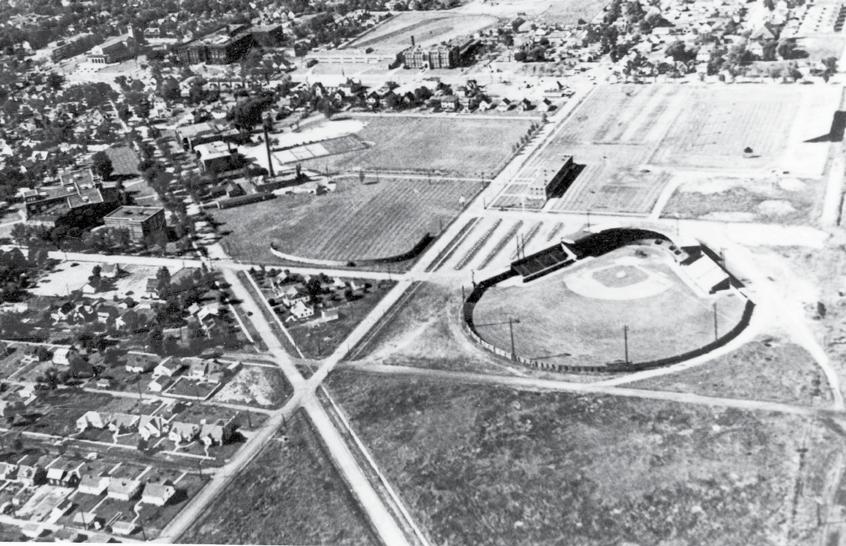
3 minute read
Fields of dreams
By Jon Nowacki jnowacki@duluthnews.com
McGhie Baseball great Joe DiMaggio visited what would eventually become known as Wade Stadium in January 1941, and, according to legend, waded through snow to take a swing at an imaginary pitch before saying, “Baby, batting out a homer in this park will be a good job for the best of ’em.”
That’s just one of countless stories about Twin Ports professional baseball history, one that goes well beyond Wade Stadium and the year 1941, and surprisingly rich for a city located in a northern clime. According to baseball-reference.com, Duluth won the Northwestern League in its inaugural pro season in 1886, going 46-33 in a six-team league featuring teams from Minneapolis to Milwaukee. Local baseball historian Anthony Bush said nicknames “were added retroactively at some point and now they’re like an invasive species, as far as I’m concerned.” The Milwaukee team, certainly, was not your father’s Brewers, or even your grandfather’s Brewers, but one of multiple Milwaukee teams to carry that name. Later there were the Duluth White Sox (1903-16, 1934) and Duluth Dukes (1935-42, 194655) of the Northern League. Across the bridge, at the old Municipal Stadium, adjacent to the WisconsinSuperior campus, you had the Superior Blues (1933–43, 1946–55). Prior to the New Deal-era parks, Duluth had Athletic Park and Superior had Hislop Park. Among the notable incidents at that time included a visit by the larger-than-life Babe Ruth at the height of his career in November 1926 as part of a vaudeville
Athletic Park in West Duluth, former home of the famed Duluth Eskimos football team. Wade Stadium, which hosted its first baseball game July 16, 1941, with the Duluth Dukes taking on their rival, the Superior Blues, appears to still be under construction. Wade Stadium’s original name was the Duluth All-Sports Municipal Stadium and was renamed Wade Municipal Stadium in 1954 to honor former Dukes owner Frank Wade, who died the previous year. Wade Stadium, constructed of bricks from Grand Avenue, is one of the last remaining stadiums from the Works Progress Administration. (L. Perry Gallagher Jr. / University of Minnesota Duluth Kathryn A. Martin Library Archives) tour, the Bambino posing with orphans at Fairlawn Mansion in Superior in a classic photo.
Tragedy struck on July 24, 1948, when the Dukes were involved in one of the worst tragedies in sports history when they were involved in a bus crash that claimed six lives, including outfielder Gerald “Peanuts” Peterson, of Proctor, and injured more than a dozen more.
Eventually Wade Stadium was home to the Duluth–Superior Dukes of the 1960s, a golden age that saw the likes of four-time Major League AllStar Willie Horton and two-time Cy Young Award winner Denny McLain — the Majors’ last 30-game winner — play for the Dukes as the team was a Detroit Tigers minor-league affiliate.

The big names funneled through the Twin Ports at that time through the Northern League were a “who’s who” of all-time greats, including legendary sluggers such as Hank Aaron and Roger Maris, and ace pitchers Don Larson and Gaylord Perry.
The Northern League disappeared, only to come back in 1993, reborn as an independent league. The Duluth-Superior Dukes were a charter member and played in the Northern League through the 2002 season before moving to Kansas City, where they became the T-Bones.
That stint wasn’t without its share of memories, with titles in 1997 (League) and 2000 (Central), not to mention Ila Borders, who in 1998 became the first female pitcher to start a men’s professional baseball game.
The Dukes were replaced by the Duluth Huskies of the Northwoods League, a collegiate summer league featuring wood bats that helps players develop and become accustomed to what minorleague baseball would be like. While the league has been a hit, it’s hard to know who’s going to be the next Pete Alonso or Max Scherzer, both league alums.
Of course, nobody watching Hank Aaron at Wade Stadium in the early 1950s knew he was going to be Hank Aaron, either.
Part of what made the revamped Northern League fun was the interesting mix of players it brought together, college players who were passed over in the draft, minor-league retreads, aging or washed up former major leaguers or players with big-league talent who had “issues.”
Count Darryl Strawberry as part of the latter. Strawberry, an eight-time MLB All-Star who struggled with addiction, was playing at Wade Stadium with the St. Paul Saints in 1996. While Strawberry would go on to win a World Series with the New York Yankees that year, at that time, he had to prove, “I still got it.”
Well, he had it, launching one that left no doubt. The line-drive home run cleared the Little League backstop beyond Wade Stadium’s centerfield fence and supposedly left a divot by second base, an estimated distance of 540 feet, but even that is argued and now part of legend. And that’s what makes baseball great.
As longtime Twin Ports baseball fan Jon Winter recalled: “I think that ball is still going.” u









